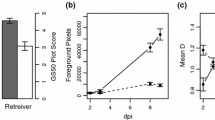Abstract
Hybrid progeny produced from a mating between a net- and a spot-type isolate of the barley net blotch pathogen Pyrenophora teres were screened to assess their viability and genetic stability. Progeny (F1) inoculated onto seedlings of the barley cultivars Stirling (highly susceptible to net-, and slightly susceptible to spot-type isolates), B87/14 and Clipper (only susceptible to spot-type isolates) produced jagged-type symptoms on all cultivars. When cultures (F1-1) isolated from leaves inoculated with Fj cultures were inoculated onto these cultivars, they produced similar symptoms. F1-2) cultures isolated from F1-1) infections also produced similar symptoms. RAPDs produced on all isolates of F1-1) and F1-2) progeny revealed identical profiles to those obtained for F1) isolates. Molecular and infection data indicated that jagged-type hybrid progeny of this net × spot mating retained their virulence and fertility overtime, and were genetically stable after two cycles of inoculation, mitosis and re-isolation. Hybridisation between net- and spot-type isolates of P. teres may, therefore, play a significant role in net blotch epidemiology in barley-growing areas.
Similar content being viewed by others
References
Bulat SA, Mironenko NV (1990) Species identity of the phytopathogenic fungi Pyrenophora teres Drechsler and P. graminea Ito et Kuribayashi. Mikologiya i Fitopatologiya 24, 435–441.
Campbell GF (2001) Genetics of pathogenicity in Pyrenophora leaf diseases of barley. PhD Dissertation, Department of Plant Pathology, University of Stellenbosch, South Africa.
Campbell GF, Crous PW (2002) Fungicide sensitivity of South African net- and spot-type isolates of Pyrenophora teres to ergosterol biosynthesis inhibitors. Australasian Plant Pathology 31, 151–155.
Campbell GF, Crous PW, Lucas JA (1999) Pyrenophora teres f. maculata, the cause of Pyrenophora leaf spot in South Africa. Mycological Research 103, 257–267.
Campbell GF, Lucas JA, Crous PW (2002) Evidence of recombination between net- and spot-type populations of Pyrenophora teres as determined by RAPD analysis. Mycological Research 106, 602–608.
Crous PW, Janse BJH, Tunbridge J, Holz G (1995) DNA homology between Pyrenophora japonica and P. teres. Mycological Research 99, 1098–1102.
Daniels A, Papaikonomou M, Dyer PS, Lucas JA (1995) Infection of wheat seedlings by ascospores of Tapesiayatlundae: morphology of the infection process and evidence for recombination. Phytopathology 85, 918–927.
Dyer PS, Papaikonomou M, Lucas JA, Peberdy JF (1994) Isolation of R-type progeny of Tapesia yallundae from apothecia on wheat stubble in England. Plant Pathology 43, 1039–1044.
Ito S, Kuribayashi K (1931) The ascigerous forms of some graminicolous species of Helminthosporium in Japan. Journal of the Faculty of Agriculture Hokkaido University 29, 85–125.
Jordan VWL (1981) Aetiology of barley net blotch caused by Pyrenophora teres and some effects on yield. Plant Pathology 30, 77–87.
Kenneth R (1962) On the taxonomy, morphology and geographic origins of Pyrenophora teres Drechsler and allied species. Bulletin, Research Council of Israel 11D, 55–82.
Louw JPJ, Crous PW, Holz G (1994) Pyrenophora japonica occurring on barley in South Africa. Plant Pathology 43, 420–423.
Louw JPJ, Crous PW, Holz G (1996) Relative importance of the barley net blotch pathogens Pyrenophora teres f. teres (net-type) and P. teres f. maculata (spot-type). African Plant Protection 2, 89–95.
Louw JPJ, Victor D, Crous PW, Holz G, Janse BJH (1995) Characterization of Pyrenophora isolates associated with spot and net-type lesions on barley in South Africa. Journal of Phytopathology 143, 129–134.
McDonald WC (1967) Variability and inheritance of morphological mutants in Pyrenophora teres. Phytopathology 57, 747–755.
Nicholson P, Dyer PS, Rezanoor HN, Lucas JA, Walkowiak-Cagara I, Hollins TW (1995) Mating relationships between different pathotypes of Tapesia yallundae, the teleomorph of the eyespot pathogen Pseudocercosporella herpotrichoides. Mycological Research 99, 457–465.
Peever TL, Milgroom MG (1992) Inheritance of triademinol resistance in Pyrenophora teres. Phytopathology 82, 821–828.
Piening L (1968). Development of barley net blotch from infested straw and seed. Canadian Journal of Plant Science 48, 623–625.
Putterill KM (1954) Some graminicolous species of Helminthosporium and Curvularia occurring in South Africa. Bothalia 6, 347–378.
Sambrook J, Fritsch EF, Maniatis TA (1989) ‘Molecular cloning: a laboratory manual (2nd edn).’ (Cold Spring Harbor Laboratory Press: Cold Spring Harbor, New York)
Schoch CL, Crous PW, Witthuhn RC, Cronright G, El-Gholl NE, Wingfield BD (2000) Recombination in Calonectria morganii and phylogeny with other heterothallic small-spored Calonectria species. Mycologia 92, 665–673.
Shipton WA, Kahn TN, Boyd WJR (1973) Net blotch of barley. Reviews in Plant Pathology 52, 269–290.
Shoemaker RA (1962) Drechslera Ito. Canadian Journal of Botany 40, 808–836.
Smedegård-Petersen V (1971) Pyrenophora teres f. maculata f. nov. and Pyrenophora teres f. teres on barley in Denmark. In ‘Yearbook of the Royal Veterinary and Agricultural University (Copenhagen)’. pp. 124–144.
Smedegård-Petersen V (1977) Inheritance of genetic factors for symptoms and pathogenicity in hybrids of Pyrenophora teres and Pyrenophora graminea. Phytopathologische Zeitschrift 89, 193–202.
Smedegård-Petersen V (1983) Cross fertility and genetic relationship between Pyrenophora teres and P. graminea. The causes of net blotch and leaf stripe of barley. Seed Science and Technology 11, 673–680.
Smith NJG, Rattray JM (1930) Net blotch, spot blotch and leaf-stripe diseases of barley in South Africa. South African Journal of Science 27, 341–351.
Steffenson BJ, Webster RK, Jackson LF (1991) Reduction in yield loss using incomplete resistance to Pyrenophora teres f. teres in barley. Plant Disease 75, 96–100.
Tekauz A (1990) Characterization and distribution of pathogenic variation in Pyrenophora teres f. teres and P. teres f. maculata from western Canada. Canadian Journal of Plant Pathology 12, 141–148.
Author information
Authors and Affiliations
Corresponding author
Rights and permissions
About this article
Cite this article
Campbell, G.F., Crous, P.W. Genetic stability of net × spot hybrid progeny of the barley pathogen Pyrenophora teres . Australasian Plant Pathology 32, 283–287 (2003). https://doi.org/10.1071/AP03016
Received:
Accepted:
Issue Date:
DOI: https://doi.org/10.1071/AP03016




